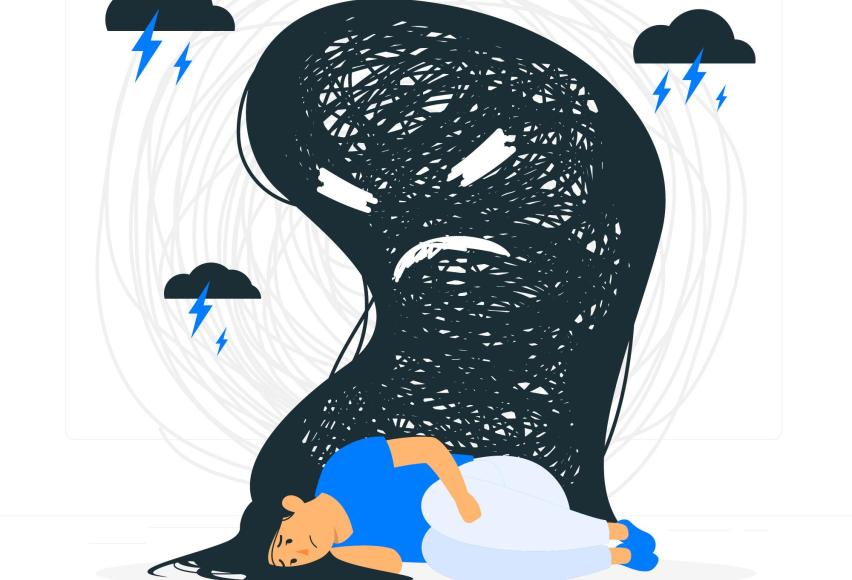Skin Picking and Depression: Can Changing Thinking Patterns Help?

Online test
Find out the severity of your symptoms with this free online test
Skin picking and other body focused repetitive behaviors (BFRBs) often co-occur with depression. It’s not unusual to see depression co-occurring with skin picking and other BFRBs. In fact, about 43% of people with hair pulling or skin picking also have depression. There’s always the question of which came first – the depression that causes the skin picking or the skin picking that causes the depression? The truth is, we don’t know but the connection is strong.
One of the things we do know is that how we think affects our behavior. In a recent Skinpick.com webinar, Dr. Sofie Wenzler takes a closer look at skin picking and depression though a cognitive behavioral lens and how changing the way you think can change your behavior.
Looking Through the Lens of CBT
Cognitive behavioral therapy (CBT) is an evidence-based approach to therapy developed by Dr. Aaron Beck. Evidence-based means that its theory and techniques are grounded in sound, scientific research.
CBT is based on the idea that our thoughts, feelings, and behavior are connected. By changing the way we think and act, we can change how we feel. CBT has long been established as the preferred approach for treating depression. A specialized cognitive behavioral approach known as Habit Reversal Training (HRT) is the gold standard for treating skin picking and other BFRBs. Both depression and skin picking can be viewed through a cognitive behavioral lens.
Depression Through A CBT Lens
Dr. Wenzler reviews the cycle of depression as viewed from a CBT perspective:
- Symptoms commonly associated with depression include feelings of persistent sadness and low mood, and loss of interest in enjoyable activities.
- These feelings can lead to behaviors such as low energy, and changes in sleep and appetite. These symptoms can lead to avoidance and becoming less socially engaged.
- These symptoms can result in negative thoughts and perceptions related to self such as low self-esteem, poor self-confidence, guilt and unworthiness.
- These negative thoughts can lead to increased feelings of sadness and depression, and increased avoidance behaviors and impairments in sleep and appetite, thus perpetuating the cycle of depression.
Skin Picking Through A CBT Lens
Similarly, you can view the cycle of skin picking through the lens of CBT. Starting with skin picking (behavior) which is the most obvious symptom:
- Skin picking results in visible damage to the skin. This in turn creates a desire to avoid or withdrawal from social interactions where others may notice or comment on the skin damage.
- That isolation can contribute to thought patterns including self-criticism, rumination and worry about what may happen, and decreased self-esteem.
- Those thought patterns in turn give rise to feelings of frustration or helplessness, guilt, shame, and anxiety.
According to cognitive behavioral theory, the cycle can be broken by changing behaviors and thought patterns. When treating depression, the focus is often on how thought patterns influence emotions. Changing thought patterns can change feelings. Treating BFRBs generally starts with treating the behavior. Adding a cognitive component to treatment can help to address the negative thought processes that influence feelings and behavior.
Thinking Errors
You may have heard Joseph Nguyen’s quote, “Don’t believe everything you think.” What that means is our thoughts are not always accurate.
Thinking errors, also known as cognitive distortions, are essentially ways of thinking that are based on our own biases and experiences and beliefs. We all have them. For example, if you believe that “everyone judges me”, you will assume that anyone you meet in any situation is going to judge you. Those biases result in automatic thinking that fits those distortions, true or not.
There’s a laundry list of cognitive distortions. Here are a few of the most common:
Jumping to conclusions – making negative assumptions about situations with no concrete evidence.
Mind-reading – assuming you know what others are thinking
Emotional reasoning – believing that your emotions reflect the absolute truth about the situation
Overgeneralization – Drawing broad, negative conclusions about yourself or others based on a single instance
Catastrophizing – Assuming the worst possible scenario will always happen
All-or-Nothing thinking – viewing situations in an extreme or either-or, all good or all bad fashion
Selective attention - focusing only on specific aspects of a situation that confirm your preconceived beliefs or fears while ignoring contradictory information
Unfair comparisons – valuing your worth based on comparisons with others
These cognitive distortions can keep you from seeing a situation as it is and keep you in those negative thought patterns that reinforce behavior. So, if we have these biases, can we change the way we think? We can!
Changing the Way You Think
You have thousands of thoughts every day. Some you’re aware of. Others happen automatically but are no less influential. Through a process known as cognitive restructuring, you can change unhelpful or unwanted thought patterns.
Changing unhelpful or negative patterns of thinking starts with being aware of them and how they affect you.
Awareness
Awareness is the first step in changing something – anything. After all, you can’t change what you don’t recognize. Two great tools for increasing awareness are journaling and practicing mindfulness.
- Journaling – Journaling can help you recognize thoughts and how they connect to feelings and behaviors. As you explore, you can begin to recognize the patterns that you might want to change.
- Mindfulness – Mindfulness is the act of being present in the moment, in the here-and-now. It allows you to pay attention to what’s happening in the moment and how you interact with your world. It can help you become more aware of how you think and patterns that might be unhelpful.
Challenge Your Thoughts
This is a core strategy in CBT. Essentially, don’t believe everything you think. Become a thought detective:
- Look objectively at the evidence before you. What evidence supports your belief? Is there evidence that contradicts your belief?
- Look at the full picture. Are there aspects of the situation I am not aware of?
- Find the grey area. Am I engaging in all-or-nothing thinking or is there a middle ground?
- Change your perspective. Could you imagine people coming to different conclusions?
- What is this thought doing to me? How do I feel when I think this way?
If you find your thoughts are inaccurate, you can give yourself permission to replace them with more accurate ones.
Behavior Experiments
Another core strategy of CBT, behavior experiments are essentially experiments that you set up to test the accuracy of your negative thoughts. You only accept the concrete evidence of your experiment, without judgment or assumptions. Based on your results, you can decide how to modify thought patterns that might be impacting your functioning and well-being.
Some people are comfortable trying behavior experiments on their own. Others prefer to work with a CBT therapist.
Ignore Your Unhelpful Thoughts
Not always easy because ignoring those thoughts first requires you to be aware of them. This is where practicing mindfulness can really be helpful. There may be times, even after you’ve challenged them, some negative thoughts may creep in. When you’re able to recognize them as unhelpful, you can choose to ignore them.
Dr. Wenzler describes a kind of “meta level” thinking as a way to manage these thoughts. You know the negative thoughts are there and may continue to be. You can choose to not pay attention to them. She likens this to having a radio channel playing in your head that you know is playing but you choose to not attend to it.
The Takeaway
Restructuring how you think takes some effort, but it is something you can do. As you learn to manage negative thinking, you may find that working on your skin picking behavior becomes more successful and your emotions are more positive. A skilled CBT therapist can help you find the strategies that work best for you.
You can view the complete webinar here.
For more information about skin picking, visit skinpick.com and subscribe to the skinpick.com newsletter. You can also subscribe to the skinpick.com YouTube channel to stay up-to-date on new video releases.
References
1. Skinpick.com. (2023, November 30). Skin Picking and Depression - How thinking patterns affect you [Video]. YouTube. https://www.youtube.com/watch?v=HPzGsA3L80I
2. American Psychological Association. (n.d.). Cognitive restructuring. APA Dictionary of Psychology. https://dictionary.apa.org/cognitive-restructuring
3. Grossman, H. (2021, June 14). Behavioral experiments in cognitive therapy. Beck Institute. https://beckinstitute.org/blog/behavioral-experiments-in-cognitive-therapy/
Online test
Find out the severity of your symptoms with this free online test
Start your journey with SkinPick
Take control of your life and find freedom from skin picking through professional therapy and evidence-based behavioral techniques.
Start Now



